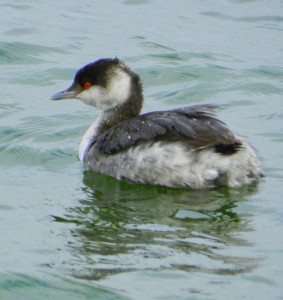
Oftentimes when they encounter grebes in the San Joaquin Valley birders are presented with an identification problem. In all, six species of grebe can be found, depending on the time of the year. Year-round residents include Clark’s and Western Grebes and the diminutive Pied-billed Grebe.
Of the three, the Pied-billed Grebe is by far the easiest to identify. In addition to its small size, the bi-colored black and white bill that gives it its name is unmistakable.
Clark’s and Western Grebes used to be considered one species. In 1985 they were “split” into two species when biologists determined their genetics and breeding behavior were sufficiently different to warrant species distinction.
Superficially, they look very much alike. Most often, birders identify them by the colors of their bills and their facial patterns. Western Grebes have dull, greenish-yellow bills. The black feathers on their crown and face extend below the red eye. The Clark’s Grebe has a brighter orange-yellow bill. The black pattern on the face stops above the eye.
Of the three other grebes sometimes present, one, the Red-necked Grebe, is very rare. Valley birders are fortunate to see one every ten years, unless they’re willing to travel to a few “staked-out” birds in distant locations.
Eared Grebes are by far the most numerous grebe in the San Joaquin Valley, but with rare exceptions, they’re here only during the winter. They have a spectacular breeding plumage that features yellowish-orange ear tufts that give them their name.
In winter, Eared Grebes lose their ear tufts. Their colorful plumage becomes charcoal and white.
Dark grey above and white below, Eared Grebes are very similar to the much less common Horned Grebe, another winter visitor. It usually takes lots of practice and close study to learn to separate the two quickly in the field, in part because birders have too few chances to make close studies of Horned Grebes.
Given a close enough look, Horned Grebes differ from Eared Grebes in at least three significant ways. In the vast majority of cases, Horned Grebes’ necks and faces are a much “cleaner” and brighter white than the necks and faces of Eared Grebes. Whereas the bills of Eared Grebes tilt upward at the tip, the bills of Horned Grebe are much more dagger-like. And finally, when it’s close enough to be seen clearly, the thin red line from the Horned Grebes’ eye to the base of its bill is definitive.
Eared and Horned Grebes spend winters on large bodies of water. Horned Grebes are present in very small numbers every year in the San Joaquin Valley, but can be hard to find. In Stanislaus County, look for Eared Grebes at Modesto and Woodward Reservoirs and on Turlock Lake. In Merced County, they can be found on San Luis Reservoir.
It’s always a minor thrill to confirm the presence of one of these unusual birds among the far more numerous Eared Grebes. And learning to distinguish their subtle field marks is good training for the birder’s eye.
